
This is an episode whose impact on the wider culture may be surprisingly large: for several decades, it has been suspected that the alien seen here unconsciously “inspired” the description of the aliens provided by Barney Hill during a hypnosis session meant to recover his memories of his and his wife Betty’s UFO abduction in 1961. Betty and Barney Hill’s story is the first example of a modern alien abduction, and the aliens in Barney’s version of the story (Betty’s earlier description of the aliens was fairly different) was the first time the now-standard “greys”, with their bulbous heads and big eyes, were illustrated—and twelve days before his recollection, on February 10th, 1964, there was this episode, which featured a bulbous-headed alien with strange eyes. It’s more or less impossible to know how true the connection is all these decades later, but it’s also not the only example of a mysterious “real life” phenomenon being secretly inspired by pop culture, as similar connections can be drawn between the original King Kong and the first Loch Ness Monster sightings—and these things illustrate how far certain ideas in culture can diffuse over time.
But, just speaking of it as an episode of The Outer Limits, this is a stylistically ambitious affair, with Joseph Stefano (who is credited with teleplay, while the story is credited to him and Lou Morheim) taking what could be a standard Sci-Fi plot and playing it as Shakespearean tragedy—almost literally, as the inspiration this episode takes from Macbeth is clear as day, sometimes to slightly ridiculous degrees. The dialogue becomes much more poetic, flowery monologues delivered with unwinking panache by an extremely qualified cast—you get the impression that everyone involved in this production knew that this one should be treated just a little bit differently. With all that, though, it still feels like its playing in The Outer Limits‘ own sense of morality, making it far better than just a condensed Macbeth with an alien inserted into it.



